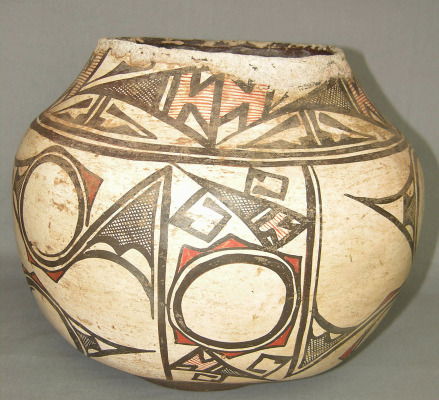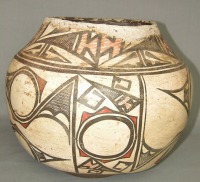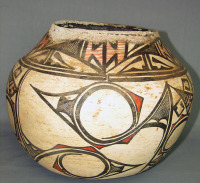Zuni Olla, c. 1890's
This Zuni Olla is 11" x 12", very good condition with ethnographic wear.
There are a very few distinctive styles of Zuni pottery during this period. This is an example of one of the few distinctive styles of Zuni pottery during this period. The lines are more flowing suggesting abstracted, avian figures. The site shows another Zuni olla of a different style, typically using heart-line dear and floral medallions.
The "ethnographic wear" refers to the deterioration around the rim. This is a result of use in the home of a Zuni Pueblo family in the 1880's. The olla was used as a water storage vessel in the home. A ladle dipped water from the olla. Afterward water would run down the neck of the ladle onto the rim, deteriorating it.
I find this personal use very endearing. There is a difference between something the Native people make for themselves and their use and something made for trade. The artist loves both but there is a more personal relationship with a piece that quenched the families thirst.
Suggested Reading: "The Pottery of Zuni Pueblo" by Dwight Lanmon and Francis H. Harlow.
There are a very few distinctive styles of Zuni pottery during this period. This is an example of one of the few distinctive styles of Zuni pottery during this period. The lines are more flowing suggesting abstracted, avian figures. The site shows another Zuni olla of a different style, typically using heart-line dear and floral medallions.
The "ethnographic wear" refers to the deterioration around the rim. This is a result of use in the home of a Zuni Pueblo family in the 1880's. The olla was used as a water storage vessel in the home. A ladle dipped water from the olla. Afterward water would run down the neck of the ladle onto the rim, deteriorating it.
I find this personal use very endearing. There is a difference between something the Native people make for themselves and their use and something made for trade. The artist loves both but there is a more personal relationship with a piece that quenched the families thirst.
Suggested Reading: "The Pottery of Zuni Pueblo" by Dwight Lanmon and Francis H. Harlow.





